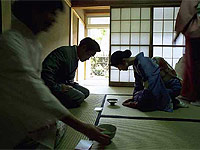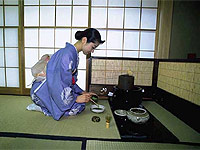Tea ceremony (part 2)
 TEA ORGANIZATION
TEA ORGANIZATION
Don’t speak words
Guest, host
White Chrysanthemum.
Tea ceremony The tea ceremony is surrounded by a special atmosphere, which the Japanese call “Wa”. In everything, from the garden and the tea house built in it to the decoration of the tea room, everything was created in order to give rise to a certain state of mind.An outdoor garden with mossy stones and an overgrown pond represents a nature that is free from human intervention, and a tea house with props made of uncouth wood or bamboo and a low thatched roof is a natural extension of it. In the tea room, twilight reigns, time here seems to have stopped. All items intended for the tea ceremony have a strictly defined shape, color and texture. Continue reading
Tea ceremony (part 1)
 Among the unique arts, which in our understanding are inextricably linked with Japan, is the art of the tea ceremony, which means literally “tea with hot water” (cha – tea, yu – hot water). The Japanese tea ceremony is not just a tradition, it is a sacrament that cannot but attract attention and arouse respect.
Among the unique arts, which in our understanding are inextricably linked with Japan, is the art of the tea ceremony, which means literally “tea with hot water” (cha – tea, yu – hot water). The Japanese tea ceremony is not just a tradition, it is a sacrament that cannot but attract attention and arouse respect.
The art of the tea ceremony has been studied for years in special schools. Despite the fact that the process itself may seem simple and natural, there is no limit to perfection in this. The Japanese girl’s ability to meet guests, place them on mats according to the Japanese tradition, make fragrant tea, and then pour them into cups with a bow to serve it is the highest sign of aesthetic education. Continue reading
What to see in Japan (part 2)
 The capital of Tokyo is the most visited tourist city in Japan. You should definitely see the Imperial Palace (former Edo Castle), Tosegu Temple, Tokyo TV tower (height 333 meters), Sunshine City skyscraper, ancient parks – Rikushen, Khibiya with regular exhibitions of chrysanthemums, Shiba Park, famous for its pagodas and temples.
The capital of Tokyo is the most visited tourist city in Japan. You should definitely see the Imperial Palace (former Edo Castle), Tosegu Temple, Tokyo TV tower (height 333 meters), Sunshine City skyscraper, ancient parks – Rikushen, Khibiya with regular exhibitions of chrysanthemums, Shiba Park, famous for its pagodas and temples.
There are more than 30 museums in the city, the most interesting of them are the National Museum of Science in Ueno Park, the Shitamashi Historical Museum, the Tokyo National Museum, the National Museum of Modern Art, the Paper Kite Museum, Tokyo Metropolitan Museum of Art, and the Idemitsu Museum with a collection of paintings and calligraphy. Continue reading
Travel to Japan
 One of the most poetic Japanese customs is the observation of autumn leaf fall. It is at this magical time of the year that the country turns into bright colors of golden foliage. At this time, many travelers come to Japan to enjoy the picturesque landscapes, especially beautiful from mid-September. Of course, this is not the only reason to visit this amazing country. Tours to Japan are full of various exciting programs.
One of the most poetic Japanese customs is the observation of autumn leaf fall. It is at this magical time of the year that the country turns into bright colors of golden foliage. At this time, many travelers come to Japan to enjoy the picturesque landscapes, especially beautiful from mid-September. Of course, this is not the only reason to visit this amazing country. Tours to Japan are full of various exciting programs.
In Japan there are many monuments of architecture and natural heritage, which it is simply impossible to pass by without being interested in their origin. One of the main spectacular sights is Himeji White Heron Castle. This oldest castle has survived to this day almost in its original form, having passed the hardships of earthquakes and a warrior. This monument is rightfully on the UNESCO World Heritage List and is a real property of Japan. Continue reading
What to see in Japan (part 1)
 Japan is a country not everyone can understand. Its rich culture, carefully guarded and holy revered traditions are wonderfully combined with the extraordinary pace of development of high technology; crazy rhythm of life in noisy cities, in which huge skyscrapers are adjacent to elegant pagodas, and the noise of cars with the murmur of small waterfalls in quiet gardens, with the majestic tranquility of the nature of this country.
Japan is a country not everyone can understand. Its rich culture, carefully guarded and holy revered traditions are wonderfully combined with the extraordinary pace of development of high technology; crazy rhythm of life in noisy cities, in which huge skyscrapers are adjacent to elegant pagodas, and the noise of cars with the murmur of small waterfalls in quiet gardens, with the majestic tranquility of the nature of this country.
Indeed, we know very little about Japan. To the question: “What would you like to see in Japan?” – many of those who are going to visit this country will not find what to answer. Meanwhile, both its nature and cultural and historical wealth are so multifaceted and diverse that everyone here will find something interesting for themselves. Continue reading


